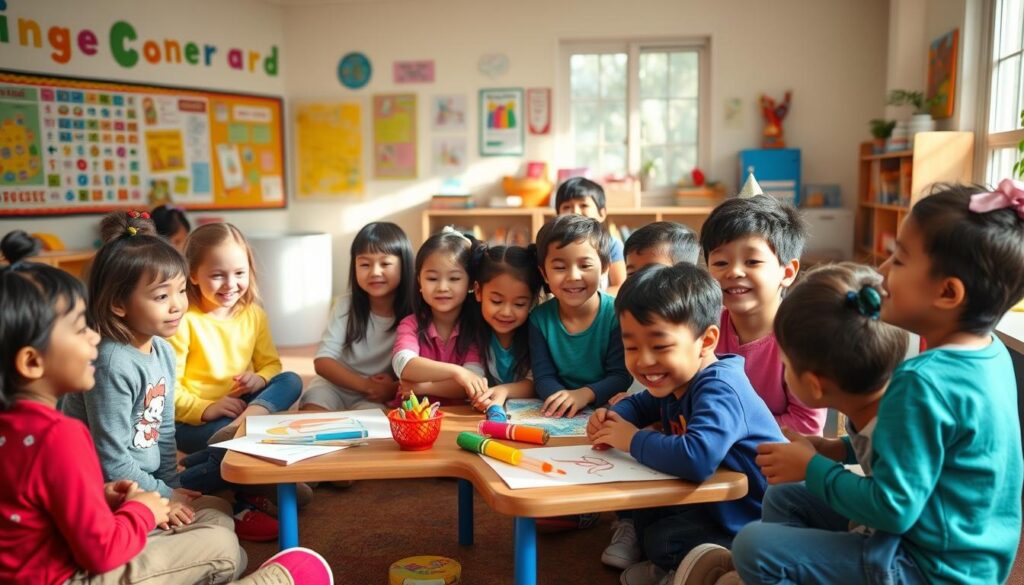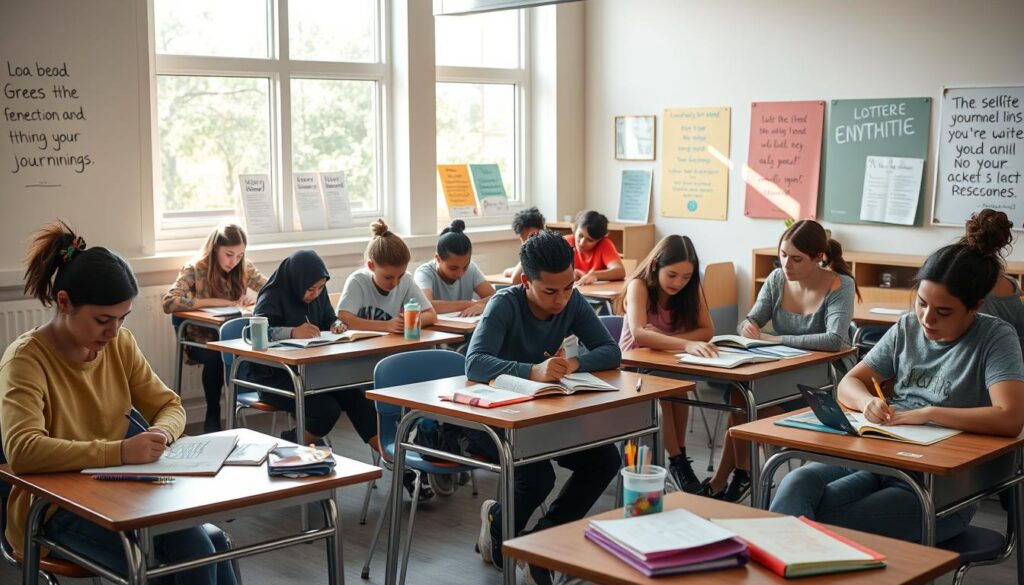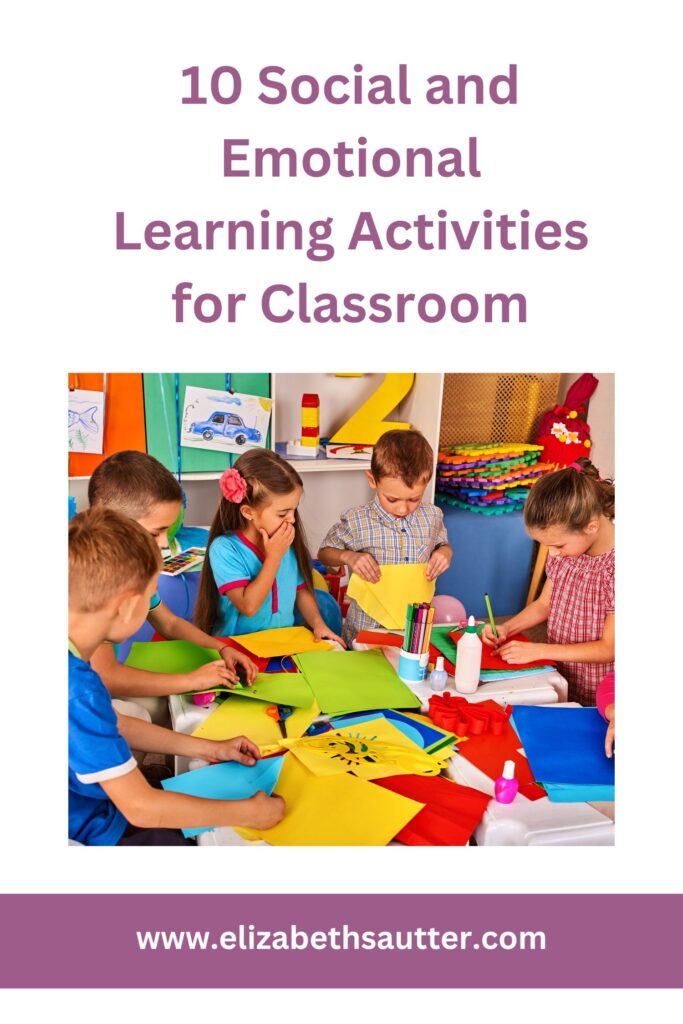In today’s fast-changing schools, teaching students about social and emotional learning (SEL) is key. SEL helps them learn important life skills like knowing themselves, understanding others, and making healthy choices. Let’s dive into 10 SEL activities that can be easily embedded into the classroom. These activities make learning fun and help students grow in all areas.

The Importance of Social and Emotional Learning
In today’s evolving world, social and emotional learning (SEL) plays a vital role in supporting all students. SEL helps young people develop self-awareness, manage their emotions, and understand and connect with others. These skills are essential for personal growth, school success, and navigating life’s challenges, honoring each student’s unique strengths and needs.
Fostering Emotional Intelligence
SEL in the classroom builds emotional intelligence, which is essential for personal growth and navigating life. When students learn to recognize and manage their feelings, they’re better equipped to handle challenges, make thoughtful decisions, solve problems, and connect with others. This foundation supports all students, honoring their unique ways of learning and interacting with the world.
Building Positive Relationships
Social and emotional learning (SEL) creates a true sense of belonging for all students, helping them connect with one another and with their teachers. Through SEL, they build skills for clear communication, teamwork, and community-building. These skills not only support academic success but also foster a positive self-image and a deeper sense of connection. By nurturing these abilities, we’re creating an environment where every student, with their unique strengths and perspectives, feels valued and included.
Collaborative Games and Activities
Collaborative group learning activities and team-building exercises are key for social and emotional learning (SEL) in class. They help students work together, talk well, and solve problems. Through these cooperative learning strategies, students learn to handle social situations, trust each other, and improve their communication skills.
“Survival Scenario” is a great group learning activity. Students find themselves stranded on a desert island and must figure out how to survive together. It boosts their communication, decision-making, and thinking skills as they work out solutions.
“Marshmallow Challenge” is another top team-building exercise. Students use spaghetti, tape, and a marshmallow to build the tallest structure. It’s all about creativity, problem-solving, and teamwork as they try to outdo each other.
For the younger crowd, “Cooperative Tic-Tac-Toe” is a fun collaborative SEL activity. Two teams work together to place their X’s and O’s. It’s a great way to encourage teamwork and communication.
By adding these group learning activities and team-building exercises to class, teachers can make learning fun and engaging. It helps students grow socially and emotionally, alongside their academic skills.
Mindfulness Exercises for Focus and Calm
In a busy classroom, it can be challenging for students to stay calm and focused, especially for those with different learning and sensory needs. Mindfulness exercises offer a helpful way to support students in finding moments of peace, which in turn enhances their ability to learn.
For example, simple breathing exercises, like “Take Five” (where students trace their fingers while breathing in and out), can help them reset and regain focus. Guided visualizations, such as imagining a calm place, can also create a sense of inner peace.Regular practices like these make it easier for all students to stay present, concentrate, and approach their work with a clearer, calmer mindset.
Breathing Techniques
Conscious breathing is a key mindfulness practice. It helps students feel more grounded and present. Simple exercises like belly breathing or alternate nostril breathing are easy to do in class. They offer students real calming exercises to handle stress and anxiety.
Guided Body Scan and Visualization for Students
Body scans combined with visualization are a fantastic way to introduce mindfulness to students. These short, structured practices help them tune into their bodies, calm their minds, and feel more present and peaceful.
During a guided body scan, the instructor leads students to focus on each part of their body, starting from their toes and moving up to their heads. Students are encouraged to notice any sensations they feel, like warmth, tension, or relaxation. This gentle focus helps them become more aware of their bodies and learn to release stress.
For added calm, the body scan can end with a visualization. Students might imagine themselves in a peaceful place—like a beach, forest, or cozy room—focusing on what they see, hear, and feel. This blend of body awareness and visualization brings them back to the moment, helping them feel centered and ready to learn.
“Mindfulness is about being fully awake in our lives. It is about perceiving the exquisite vividness of each moment.”
– Jon Kabat-Zinn
Incorporating focus and concentration strategies into daily routines can have a transformative impact on students. These practices boost academic success, emotional well-being, and create a calmer, more supportive classroom environment. By introducing simple mindfulness exercises, like body scans or short meditations, teachers empower students to approach school challenges with greater confidence, resilience, and clarity.
Role-Playing and Empathy-Building Activities
Building empathy and understanding among students is key for their growth. Role-playing and perspective-taking exercises are great ways to do this. They help students see things from another’s point of view, grow compassion, and improve their social skills.
Perspective-Taking Strategies
Perspective-taking exercises make students think deeply and talk well. They imagine being in someone else’s shoes, like a classmate or a historical figure. This way, they understand different lives and handle social situations better.
For instance, in a role-play, students might play different roles in a community issue. They discuss it from all sides. This teaches them to listen well, solve problems, and resolve conflicts.
Role-play and perspective-taking activities boost emotional intelligence and improve relationships.
SEL drama activities, like improvisation or scripted scenes, help students practice social skills safely.
These strategies help students see things from others’ viewpoints, grow compassion, and deal with complex situations better.
By adding these activities to the classroom, teachers help students develop important social skills. These skills are useful in school and life.
Social and Emotional Learning Activities
Teaching social and emotional learning (SEL) in school is key for students’ growth. Teachers use many fun activities to help students learn important life skills. These SEL activities for students help them do well in school and face life’s challenges.
There are many classroom SEL exercises like team games and mindfulness. These activities help students understand their feelings, talk better, and get along with others. By using these social-emotional learning techniques, students learn a lot about themselves and others.
Role-playing is a great emotional learning activity. It lets students see things from another’s point of view. This boosts their empathy and helps them deal with tough social situations. Journaling and self-reflection also help students know themselves better and control their emotions.
SEL Activity | Description | Targeted Competencies |
Cooperative Problem-Solving | Students work in teams to tackle challenges, practicing communication, collaboration, and critical thinking. | Relationship skills, responsible decision-making |
Gratitude Circles | Students take turns expressing gratitude and appreciation for their classmates, fostering a positive classroom community. | Self-awareness, social awareness |
Emotion Charades | Students act out different emotions, helping their peers recognize and name various feelings. | Self-awareness, social awareness |
By using different SEL activities for students, teachers can make a caring classroom. These social-emotional learning techniques improve school work and prepare students for life.
“Social and emotional learning is not just a ‘nice-to-have’ – it’s a ‘must-have’ for preparing students to thrive in school, career, and life.” – CASEL
Journaling and Self-Reflection
Journaling and self-reflection are key parts of social and emotional learning (SEL). They help students explore their thoughts, feelings, and experiences. This way, educators can help students grow emotionally, become more aware of themselves, and improve their thinking skills.
Prompts for Emotional Expression
Creating good prompts is crucial for journaling in SEL. These prompts should help students dive into their feelings, leading to real self-expression and a better understanding of themselves. Here are some examples:
Describe a time when you felt really proud of yourself. What made you feel that way, and how did it change your actions?
Think about a tough situation you faced lately. How did you handle your emotions, and what did you learn about yourself?
Write about someone who has really made a difference in your life. How have they influenced your views and values?
Through these journaling activities for SEL, self-reflection exercises, and emotional expression prompts, students gain valuable insights. These insights support their social and emotional growth.

Classroom Community-Building Activities
Creating a strong classroom community is key for social and emotional learning. Icebreakers and team-building games help students bond, build trust, and support each other. These activities promote teamwork, communication, and celebrate diversity, making the classroom a welcoming place.
Icebreakers and Team-Building Games
Icebreakers are perfect for starting conversations and helping students meet. Some fun icebreaker activities include:
Two Truths and a Lie: Students share two true and one false fact about themselves. The class guesses which is the lie.
Scavenger Hunt: Teams search the classroom for items or complete tasks, boosting teamwork and communication.
Marshmallow Challenge: Teams build the tallest structure with spaghetti, tape, and a marshmallow. It’s all about teamwork and problem-solving.
Team-building exercises also help groups work better together. Examples are:
- Collaborative Artwork: Students create a mural or collage together, showing the power of teamwork in creativity.
- Human Knot: Students hold hands in a circle and untangle without letting go. It’s a great way to practice teamwork and communication.
- Balloon Tower: Teams build the tallest tower with balloons and tape. It tests their problem-solving and planning.
By using these icebreakers and team-building games, teachers can create a lively and inclusive classroom. This sets the stage for deep social and emotional learning experiences.
Emotion Regulation Strategies
Learning to manage emotions is key for social and emotional growth. This part talks about how to help students handle their feelings in a good way. By teaching them to understand and deal with their emotions, teachers help them face tough times, grow strong, and keep good friendships.
Identifying and Managing Emotions
Knowing yourself is the first step in managing emotions. Activities that help students understand their feelings are very helpful. These can be things like keeping a journal, identifying emotions, and talking about how feelings affect our lives.
Students also need to learn ways to handle hard emotions. This can include deep breathing, being mindful, and finding healthy ways to share feelings. Teachers can give students tools to deal with life’s ups and downs, making them more emotionally smart and resilient.
Emotion Regulation Strategies | Key Benefits |
Journaling | Promotes self-awareness and emotional expression |
Breathing Exercises | Reduces stress and anxiety, increases focus |
Mindfulness Meditation | Enhances emotional regulation and impulse control |
Positive Self-Talk | Boosts self-esteem and resilience |
By using different emotion regulation strategies in class, teachers help students get the skills they need for success in school and life.
Conflict Resolution and Problem-Solving Activities
Learning to solve conflicts and problems is key in social and emotional learning. These skills help students deal with challenges and find good solutions. They learn to communicate well, see things from others’ viewpoints, and make decisions together.
Doing different conflict resolution activities and problem-solving exercises is very helpful. Students get to practice managing disputes and solving big issues. They try out role-playing, group talks, and more. These help them see things from other angles, negotiate, and find solutions that work for everyone.
- Collaborative decision-making exercises that foster teamwork and shared responsibility
- Structured debates or discussions that allow students to articulate their positions and listen actively
- Dispute management strategies that emphasize effective communication and conflict de-escalation
- Problem-solving challenges that require critical thinking, creativity, and compromise
By adding these conflict resolution activities and problem-solving exercises to class, teachers help students. They become good at solving conflicts and finding new ways to solve problems. This helps them work well together, be resilient, and grow in school and life.
Celebrating Diversity and Inclusion
Learning about diversity and creating an inclusive space are key parts of social and emotional learning. Through cultural awareness activities, students learn to appreciate differences and challenge biases. They also feel a sense of belonging in the classroom.
These activities help students get ready for a world that’s getting more diverse. They learn to navigate this diversity with confidence.
Cultural Awareness Activities
Exploring different cultures, holidays, and customs is a great way to celebrate our global community. Students can research and share their own cultural backgrounds. Or, invite guest speakers from different backgrounds to share their stories.
Interactive activities like trying traditional foods, learning dances, or making art inspired by diverse cultures help students understand the world better. They gain a deeper appreciation for the richness of our global community.
Another good strategy is to include diverse perspectives in the curriculum. Use reading materials, audiovisual resources, and lesson plans that show the contributions of people from different backgrounds. This helps challenge stereotypes, builds empathy, and creates a more inclusive classroom.
Diversity and Inclusion Activities | Benefits |
Multicultural Potluck | Celebrate diverse culinary traditions, promote cross-cultural exchange |
Identity Presentations | Encourage students to share their unique backgrounds and perspectives |
Global Music and Dance Workshops | Immerse students in the richness of diverse cultural expressions |
Diversity-Themed Book Club | Expand students’ understanding of different lived experiences |
Integrating SEL into Academic Lessons
To really make social and emotional learning (SEL) work, we need to use it in many subjects. Teachers can add SEL to their lessons. This way, students learn important life skills and get better at their schoolwork.
Cross-Curricular Connections
When we put social-emotional learning into different subjects, students get smarter in many ways. They learn to understand people better and do well in school. For example, they can see how characters in books feel or how history affects people.
Also, incorporating SEL into lesson plans helps students see how their personal growth helps them in school. This makes them not just learn facts but also get ready for life’s challenges with kindness and confidence.
FAQ
What are the benefits of incorporating social and emotional learning (SEL) activities in the classroom?
SEL activities in the classroom boost emotional intelligence and build positive relationships. They help students develop life skills like self-awareness, empathy, and responsible decision-making. This leads to better academic and social-emotional outcomes.
What are some examples of collaborative games and activities for SEL?
Games and activities like group problem-solving and team-building are key for SEL. They help students work together, communicate well, and develop important skills.
How can mindfulness exercises help students with focus and calm?
Mindfulness exercises, like breathing techniques and guided meditations, improve focus and calm. They help students manage stress and anxiety better. This makes them more engaged in learning.
What are some role-playing and empathy-building activities for the classroom?
How can journaling and self-reflection support social and emotional learning?
Journaling and self-reflection help students understand their emotions and develop self-awareness. They allow students to express and process their feelings in a healthy way.
For more neurodiversity-affirming strategies, visit ElizabethSautter.com.
Discover free tools, workshops, and tips for building social-emotional skills that stick. Let’s create a world where every teen thrives—this year and beyond.

